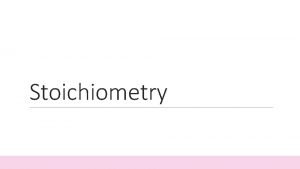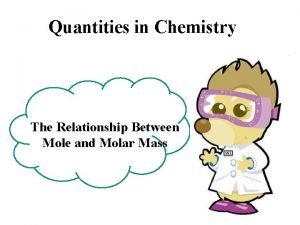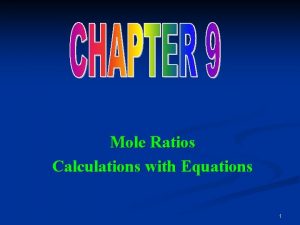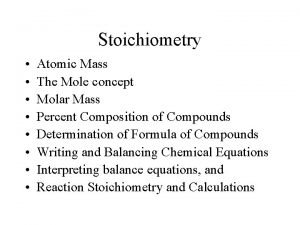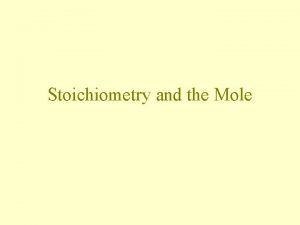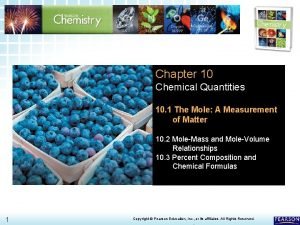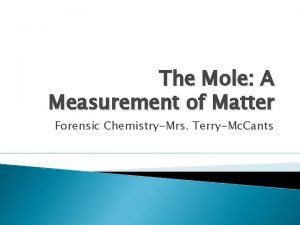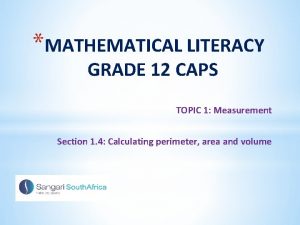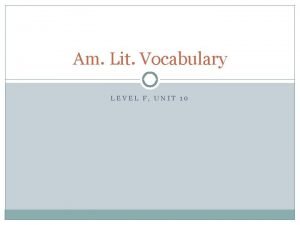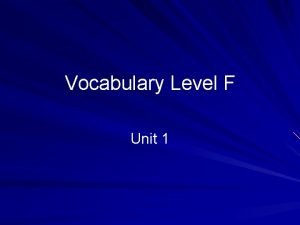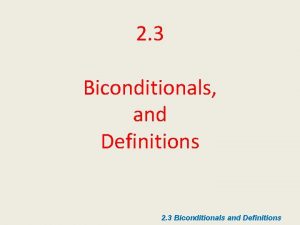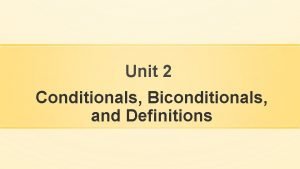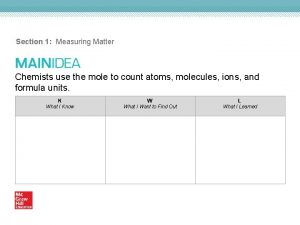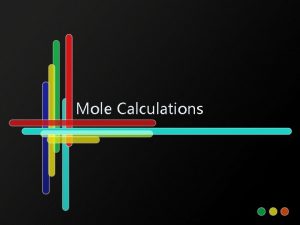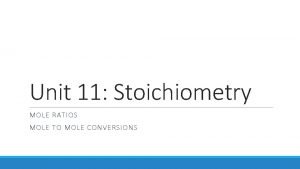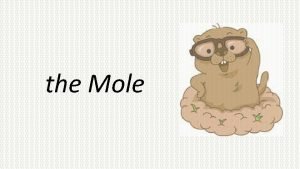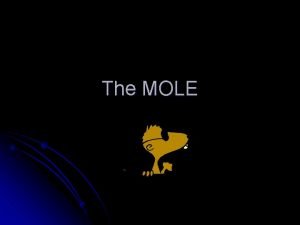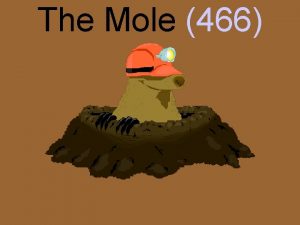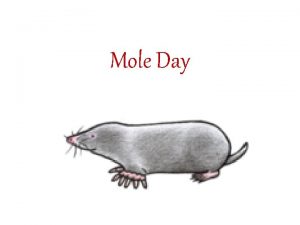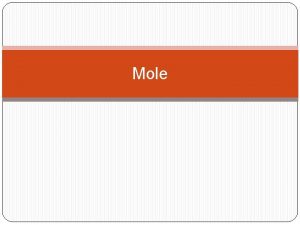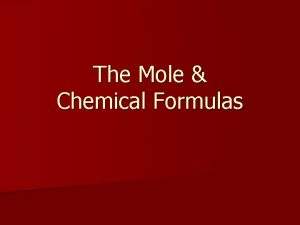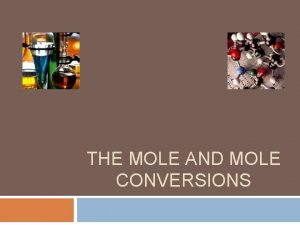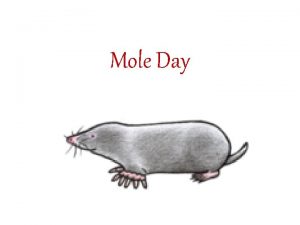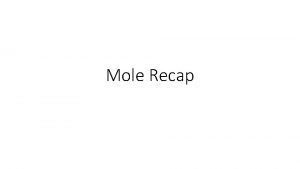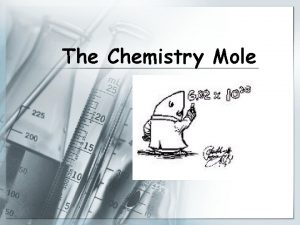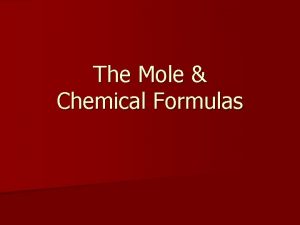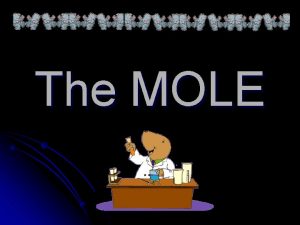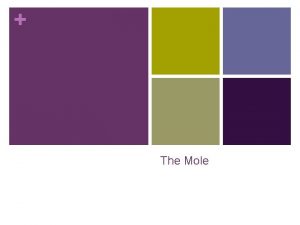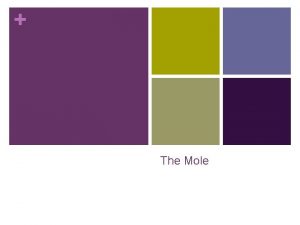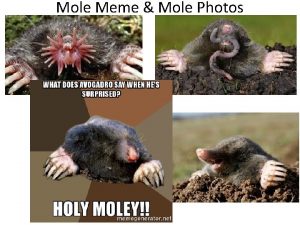New Measurement Unit The Mole 3 mathematical definitions




















- Slides: 20


New Measurement Unit: The Mole 3 mathematical definitions: 1) 1 mol= atomic mass of atom = molecular mass of a mlc = formula mass of an ionic compound MOLAR MASS These values come from the periodic table. The atomic mass #’s are in grams/1 mol

Calculating Formula Molecular mass Need periodic table (keep the decimal numbers) Count the number of atoms in a substance and multiply it by it’s mass number then add. Ex 1) K (atom) 39. 098 g = atomic mass 1 mol Ex 2) P (atom) 30. 974 g = atomic mass 1 mol

Ex 3) Potassium Chloride - KCl (formula unit) 1 K x 39. 098 1 Cl x 35. 453 = 74. 551 g/mol 74. 551 Ex 4) Magnesium Chloride - Mg. Cl 2 1 Mg x 24. 305 = 24. 305 2 Cl x 35. 453 = 70. 906 95. 211 g/mol Ex 5) Ammonium Carbonate - (NH 4)2 CO 3 2 N = 28. 02 8 H = 8. 08 1 C = 12. 01 3 O = 48. 00 = 96. 11 g/mol

2) 1 mol= 6. 02 x 1023 particles (avagadro’s number) where a “particle” can be: a) molecule b) atom c) ion d) formula unit of ionic cmpd 3) 1 mol= 22. 4 L for gas molecules

Volume of gas at STP formula mass, atomic mass, or molecular mass Mass 22. 4 dm 3 / mole at STP (gases only) Moles 6. 02 x 1023 particles/ mole (Avogadro Number) number of particles (atoms, ions, molecules, formula units)

One-Step Conversion Problems Use road maps to convert between one unit of chemical quantity to another. Dimensional Analysis – like metrics Use three definitions of a mole; an extension of the definitions in numerical form.

One-Step Conversion Problems These are your conversions factors! 1) 1 mole or x grams 1 mole 2) 1 mol or 6. 02 x 1023 particles 3) 1 mol 22. 4 L or 6. 02 x 1023 particles 1 mole 22. 4 L 1 mol GASES ONLY!

One- Step Conversions Ex 1) Convert 4. 3 grams of Na. Cl to moles. Mass mol Given: Unk: 4. 3 g Na. Cl x 1 mol Na. Cl = 7. 4 x 10 -2 mol Na. Cl 58. 45 g Na. Cl Ex 2) Convert 0. 00563 mol NH 3 to grams. Mol -> mass G: U: 0. 00563 mol NH 3 x 17 g NH 3 =9. 57 x 10 – 2 g NH 3 1 mol NH 3

More One-Steppers Ex) Given: 0. 91 Mol Na. Cl. O 3 Unk: ? Formula Units Na. Cl. O 3 Ex) Given 22. 92 x 1018 mlcs Cl 2 Unk: ? Mol Cl 2

More One-Steppers Ex) Given: 460. Mol Cl 2 gas Unk: ? L Cl 2 Ex) Given 84. 56 L Cl 2 Unk: ? Mol Cl 2


TWO –STEP CONVERSIONS Ex 1) Given: 8. 631 x 1021 atoms Na Unkn: ? g Na

TWO –STEP CONVERSIONS Ex 2) Given: 1. 5 x 1022 f. u. Mg. Cl 2 Unkn: ? g Mg. Cl 2

TWO –STEP CONVERSIONS Ex 3) Given: 2. 63 L O 2 Unkn: ? mg O 2

% Composition Definition: the % (in mass) of each element in a compound % mass element = g element x 100% g compound Ex An 8. 40 g sample of flourine completely combines with a 4. 90 g sample of sodium. Calculate the % composition of the compound that forms. mass element 1 + mass element 2 = total; 8. 40 g F 2 + 4. 90 g Na = 13. 30 g Na. F %F: 8. 40 g x 100 = 63. 2% F 13. 30 g %Na: 4. 90 g x 100 = 36. 8% Na 13. 30 g

% mass Cu. SO 4 1 Cu x 63. 546 g = 63. 546 g 1 S x 32. 066 g = 32. 066 g 4 O x 15. 999 g = 63. 996 g x 159. 608 g % Cu= 63. 546 x 100 = 39. 8% 159. 608 % S= 32. 066 x 100 = 20. 1% 159. 608 %O= 63. 996 x 100 = 40. 1% 159. 608

HYDRATES Compounds with water molecules chemically attached to ionic crystalline structure formula – Cu. SO 4 5 H 2 O name – copper (II) sulfate pentahydrate Ca. SO 4 4 H 2 O Ba. Cl 2 9 H 2 O – H 2 O mlcs can be removed by heating the compound. This is not evaporation. Therefore, it is NOT a physical change. (Decomposition reaction)

HYDRATES Compounds with water molecules chemically attached to ionic crystalline structure formula – Cu. SO 4 5 H 2 O name – copper (II) sulfate pentahydrate Ca. SO 4 4 H 2 O Ba. Cl 2 9 H 2 O – H 2 O mlcs can be removed by heating the compound. This is not evaporation. Therefore, it is NOT a physical change. (Decomposition reaction)

Mole-to-Mole Relationships Decomposition of water: 2 H 20 2 H 2 + O 2 2 mol of H 20 yields 2 mol H 2 and 1 mol O 2 Ex) You have 4 mol of water. If you decompose 4 mol of water, how many mols of products do you get? 2[2 H 2 O 2 H 2 + O 2] 4 H 2 O 4 H 2 + 2 O 2 4 mol of H 2 O yields 4 mol of H 2 plus 2 mol of O 2
 Unit of moles
Unit of moles Mole unit of measurement
Mole unit of measurement Mole problem
Mole problem Mole-mole factor
Mole-mole factor Stoichiometry worksheet #2 (mole-mass mass-mole problems)
Stoichiometry worksheet #2 (mole-mass mass-mole problems) Phosphorus + oxygen equation
Phosphorus + oxygen equation Stoichiometry mole-mole
Stoichiometry mole-mole Converting mass to moles
Converting mass to moles Mole mass and mole volume relationships
Mole mass and mole volume relationships What is mathematical economics
What is mathematical economics The mole a measurement of matter
The mole a measurement of matter 10.1 the mole a measurement of matter
10.1 the mole a measurement of matter Mole measurement examples
Mole measurement examples The mole a measurement of matter
The mole a measurement of matter Different types of scales in maths lit
Different types of scales in maths lit Measurement maths literacy grade 12
Measurement maths literacy grade 12 Vocab level f unit 10
Vocab level f unit 10 Vocabulary level f unit 1
Vocabulary level f unit 1 Unit 3 lesson 2 biconditionals and definitions
Unit 3 lesson 2 biconditionals and definitions Write each sentence as a conditional
Write each sentence as a conditional Why do chemists use the mole
Why do chemists use the mole
